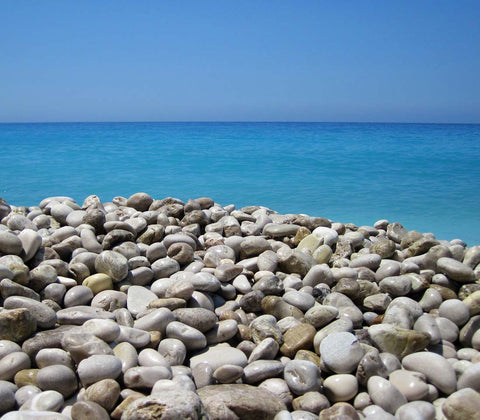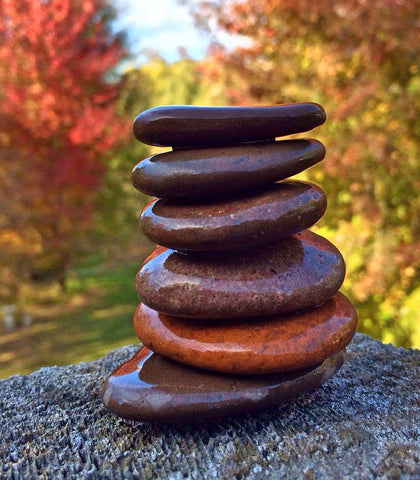Before there were fidget spinners and mind-numbing mobile games, there were worry stones. It’s just about the simplest form of natural medicine! Read on to learn about worry stones and what they can do for you.
What’s a Worry Stone?
A worry stone is a smooth rock used to soothe stress and anxiety. It is a versatile aid for self-calming and meditation. Worry stones may be as small as a thumbprint or as large as the palm of your hand. Larger worry stones may be called palm stones, and look like the oval-shaped rocks used for stone massage.
You can buy, find, or make a worry stone. Rivers and tidal pools are a natural source for water-smoothed rocks, if you'd like to collect your own. (Be sure to stay mindful of the local laws and ecology.) Alternatively, buy river stones from a craft, garden, or home décor store.
The most familiar kind of worry stone is a small, thin piece of gemstone with an indentation for the thumb. They became popular in the 1970s as a retail checkout item, along with mood rings and friendship bracelets. They are available in many different types of stone.

Worry stones may be plain or painted/engraved in various designs. Some worry stones are decorated with words of inspiration and encouragement. Religious symbols or sacred animals are also popular worry stone motifs.
Other names for worry stones include fidget stone, soothing stone, sensory stone, or thumb stone. Some people think the phrase “worry stone” is too negative—if that’s the case, call it your lucky stone or friendly stone.
History of Worry Stones

Nobody really knows how worry stones got their start, but it was probably very early in human history. They are literally as old as dirt! It’s easy to imagine a bummed-out cave-person noticing an especially smooth stone in the dust and to begin fiddling with it.
There’s just something calming about the weight and texture of natural stone. The ancient Greeks are usually credited with the invention of the worry stone—though similar concepts exist among Native American tribes, Tibetan Buddhists, and other cultures around the world.
Greece’s many miles of rough coastlines yield stones smoothed naturally by the sea. In modern Greece and Cyprus, komboloi (worry beads) are found in nearly every tourist shop. Unlike rosaries and Indian prayer beads, Greek worry beads do not usually have a religious/spiritual meaning. They are carried as a fashion accessory or a pleasant way to pass the time.
In Ireland, worry stones are made from Connemara marble, a green-veined, serpentine-rich stone from that region. Rubbing a piece of Connemara marble is said to make worries disappear and to bring good luck.
Worry stones have a place in Wiccan and Pagan practice, as well as New Age crystal healing. Different varieties of stone have different vibrational energies, which can affect the user in positive ways. Worry stones can be used to ground or disperse negative feelings and energies. All stones correspond to the element of Earth, which offers gifts of patience, stability, and rest.
Materials for Worry Stones
No surprises here—stone is the most popular material for worry stones. The natural beauty, hardness, and heaviness of stone makes it ideal for relaxation and meditation. However, you can also find worry “stones” made from bone, ceramic, metal, wood and glass.
What is the best material for a worry stone? It all depends on what colors and textures are the most appealing to you. What evokes relaxation? Or love? Or confidence? You may also wish to choose a worry stone that matches your birthstone, or other material that is significant to you.
Here are a few of our recommendations for worry stones:
Black Onyx or Black Agate is a dark stone that can be polished to a mirror finish. Both stones are durable enough for daily use and have powerful grounding properties. Black stone is excellent for absorbing negative or overabundant energy and releasing it back to Earth. Reach for a Black Agate or Onyx worry stone when you feel jittery, angry, or in need of psychic protection.
Rose Quartz is a stone of pure, unconditional love. It has a gentle energy and blush-pink color that soothes most worries on sight. Rose Quartz is an excellent worry stone to give to someone who is healing from a physical or emotional trauma. (All Quartz objects have lines of cleavage that are vulnerable to splitting. So avoid banging your Rose Quartz worry stone around or dropping it on a hard floor.)
Jasper is an opaque stone that may be red, brown, yellow, or green. It comes in a huge variety of colors and patterns, many of which are unique to specific locations. Jasper is said to be a lucky stone that inspires courage. Intricately patterned Jasper may be called Picture Jasper, and is a reminder of the infinite beauty and creativity of the Universe.
How to use a worry stone

If you’re worrying about how to use a worry stone…well, you may have more problems than this article can solve. Even so, people do sometimes ask us how to use their worry stone. (For the record: There is no right or wrong way to use your worry stone, but there are different ways to employ it in your practice.) Here are some suggestions for putting your worry stone to work:
Rub it when you feel worried or stressed.
Worry stones have enormous power to soothe frazzled nerves. They are discreet, inexpensive, and all-natural. People who use worry stones report that they help ease creeping anxiety and other negative feelings.
Research has shown that physical activity—even slight touch or movement—interrupts the brain from playing negative thoughts. Rub your worry stone between thumb and forefinger whenever anxiety strikes. While it may not solve your problems, it will diminish the intensity of the worry and help you move toward positive solutions.
Carry it with you.
Emotional self-regulation is a skill that can be learned. Once you’ve practiced setting aside negative thoughts and feelings, an object like a worry stone can be a useful aid in accessing this skill. Psychologists refer to it as triggering a “relaxation script.” In other words, once you see and handle the worry stone, you remember what it feels like to chill out.
If you know you’re going to be in a stressful situation—like being in a crowd or giving a presentation—place your worry stone somewhere you know you will be able to access it if you want to. The presence of a favorite stone can help you relax without ever taking it out of your pocket.
Meditate with your worry stone.
Stones have been used for millennia as an aid to meditation and prayer. Rubbing the stone helps focus the mind and eliminate distractions.
Not religious? You don’t need to be. Even the simplest worry stone is a unique creation that is millions of years old. It’s an excellent way to put your current problems into perspective.
Use it in magick spells.
Most types of stone are excellent for absorbing and holding energy when used as a component in a magick spell. Witches refer to this as “charging.” You can charge a worry stone for just about any purpose—prosperity, love-drawing, peace, or protection. Try anointing the stone with a corresponding oil or incense while visualizing your intention. When the ritual is complete, carry the stone with you or place it on your altar.
Give one as a gift.
A worry stone (along with a kind note) makes a thoughtful gift for a friend or family member who is experiencing stress. The gift of a worry stone says, “I know you have a lot to worry about, and I wish you comfort.” They will think of your love every time they see the worry stone! Don’t gift a used worry stone unless you have energetically cleansed it first.
Therapeutic Uses of Worry Stones

All the anecdotal benefits around worry stones seem to have caught the attention of mental health professionals, some of whom now recommend worry stones for therapeutic purposes.
Worry stones may help with skin picking, fingernail biting, hair pulling, and other compulsive behaviors. They are also used for treating addiction and for smoking cessation. Generally, touching the worry stone replaces the behavior that is being corrected. Playing with it keeps the hands and mind busy until the urge passes.
Worry stones are also used to help cope with sensory integration disorder, especially in children.
Cleansing a Worry Stone

Being in proximity to a worried person means that worry stones can sometimes pick up negative energy—in addition to dead skin, natural oils, and finger crud. If your worry stone has begun to look or feel less than shiny, it may be time to give it a good cleansing.
Most worry stones are safe to wash with gentle soap and water. (Exceptions are Selenite, Halite, and other water-soluble crystals). Energetic cleansing may be done by the method of your choice. Place your worry stone in a bowl of salt or leave it outside under moonlight or sunlight until it feels squeaky clean again.
What does it mean when a worry stone breaks?

The breakage of a favorite stone or amulet causes a lot of concern among magickally-minded folks. Psychic stress or physical handling (or a combination of the two) can be enough to make a worry stone split into pieces.
But never fear! However surprising it may be, a broken worry stone is not a sign of a curse or a bad omen. People will often say that a cracked crystal has “done its job” or “retired” and see it as a sign to move on. Some people’s energy seems to be harder on the stones than others—it’s just one of those weird things. I recommend placing the pieces in a stream or flowerbed to help disperse any personal energy…then shopping for a new worry stone.
Thanks for reading! Check out more articles in the archive, or shop for worry stones.





